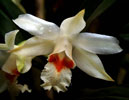|
|
|
|
|
| |
Flasks of
Dendrobium williamsonii 'Halcyon' × '#3' |
|
| |
|
|
| |
| Number: |
TN4961 |
| Name: |
Dendrobium williamsonii 'Halcyon' × '#3'
|
| Type: |
outcross (What's that?) |
|
Seed Donor: |
Dale Borders
|
|
Click to Enlarge

Pod Parent Flower |
Click to Enlarge

Pod Parent Blooming Plant |
Click to Enlarge

Pollen Parent Flower |
|
|
|
| |
Culture Notes from Donor: Pod parent plant: Temperature range I (60-83°F). Best grown with a large diurnal temperature range in winter to initiate bloom.
Pollen parent plant: Temperature range I (60-83°F)
Comments: Pod parent plant: A rewarding species. Blooms on canes 4-5 years old. The 2.5 inch (6.35 cm) flowers have a 'new car' scent.
For additional origin/habitat information supplied courtesy of
Charles and Margaret Baker, see further below, near the bottom of this page.
|
Temperatures we attempt to use in the lab & greenhouse:
| For Species: |
|
Spring, Summer, Autumn, Winter: days average 75°F, nights 63°F; best fit is Cool-Intermediate 75-58°F
(Source:
Baker's Web OSC) |
| For Species: |
|
Winter: days average 62°F, nights 38°F; best fit is Cold 58-38°F
(Source:
Baker's Web OSC) |
|
About the name...
| Etymology of |
Dendrobium |
|
From Greek "dendron" tree and "bios" life.
(Source:
Pridgeon 1992) |
| Etymology of |
williamsonii |
|
Named for W. Williamson, English orchid enthusiast of the 19th century.
(Source:
Mayr & Schmucker 1998) |
| Pronunciation of |
Dendrobium |
|
den-DRO-bee-um
(Source:
Pridgeon 1992) |
|
If you would like to direct someone to this web page, please copy and paste this URL into your email:
http://troymeyers.com/d?014961
| Flask Information |
| Availability: |
We have sold all of the flasks for this item. |
| You should: |
Consider getting individual plants or compots instead of a flask.
You can place a "Notify Flask Recipients" Request, and either we or a flask recipient may contact you when plants are available.
You may also place a "Notify Retries" Request, and if an identical pollination (the same parents) is done again, we'll let you know.
You may reserve a flask, but it's very unlikely you'll get one ...this could only happen if we found a flask that we didn't know we had. |
| Yield Estimate: |
390 plants (based on flask surveys done 04/08/2008 through 12/03/2009)
|
| Plantlet Sizes: |
From many flasks 20 - 65 mm plants (based on flask surveys done 10/14/2008 through 05/03/2010)
From one most recently surveyed flask 35 - 65 mm (05/03/2010)
|
|
You might also want to:
|
View the seed assay for this item.
View items of the same species.
View items of the same genus.
|
| Ordering Information |
| You are not currently logged in. |
|
You must be a registered user and be logged in to reserve a flask or place a notification request. Please log in:
|
|
|
|
|
|
| |
The origin/habitat information below is supplied courtesy of Charles and Margaret Baker
The following information is based on the name of the plant provided by the donor, and assumes that the name is correct. If the plant has been misidentified, then the following information may not be correct.
This text is copyrighted by the Bakers and may not be reproduced without permission.
ORIGIN/HABITAT: India and Southeast Asia. In India, plants grow near
Gangtok in Sikkim, in the Khasi (Khasia) Hills in Assam, and in the
Manipur district. They are also found near Nam Hat in upper Burma and in
western Yunnan Province of China. Plants usually grow at 3600-5900 ft.
(1100-1800 m). Plants called D. wattii originated in Manipur and West
Bengal, India, D. williamsonii originated in Assam and the Khasi (Khasia)
Hills, and D. luebbersianum originated in Borneo. Seidenfaden (ref. 454)
indicates that plants have been reported in Thailand and Vietnam, but he
questions their actual occurrence in these areas.
More about this information and the Bakers...
|
|
|
| |
|
|
|